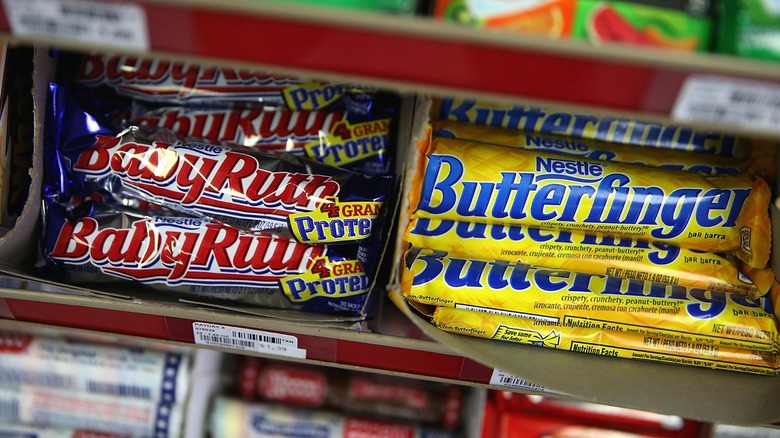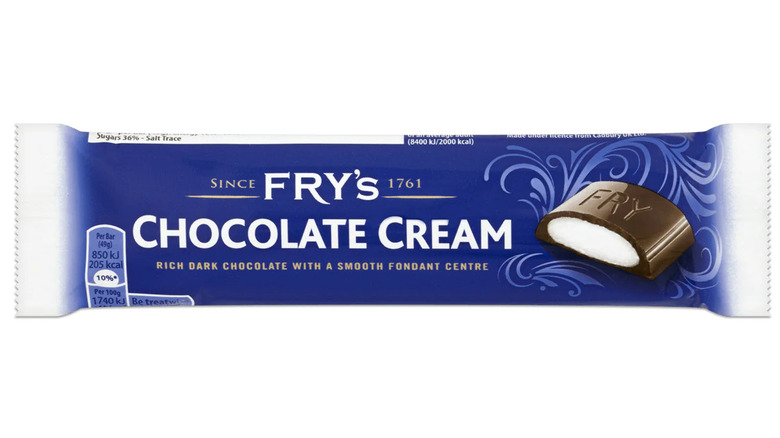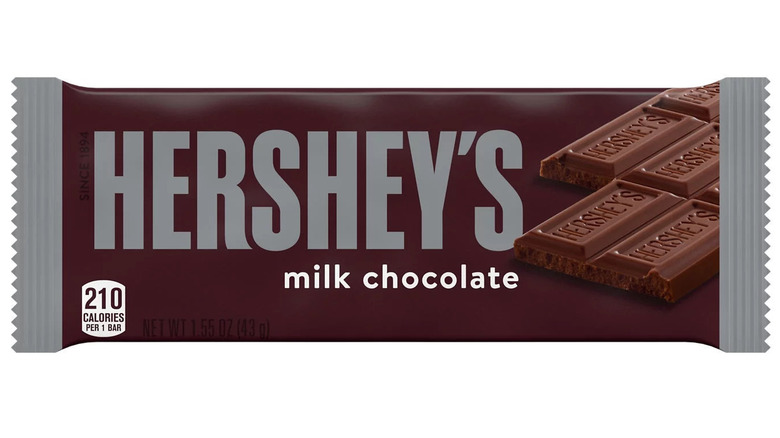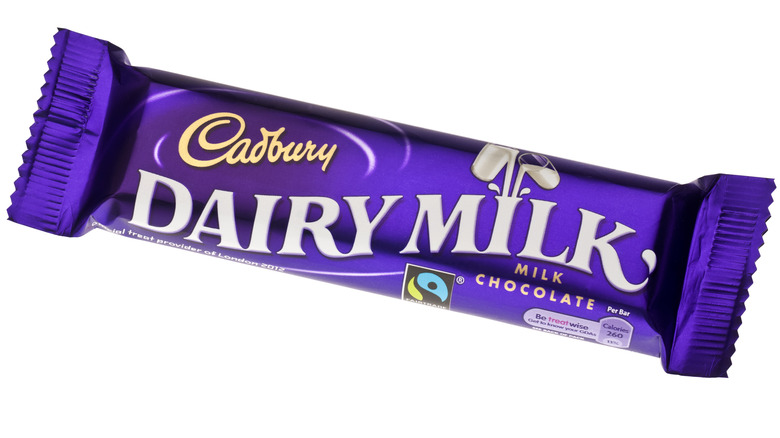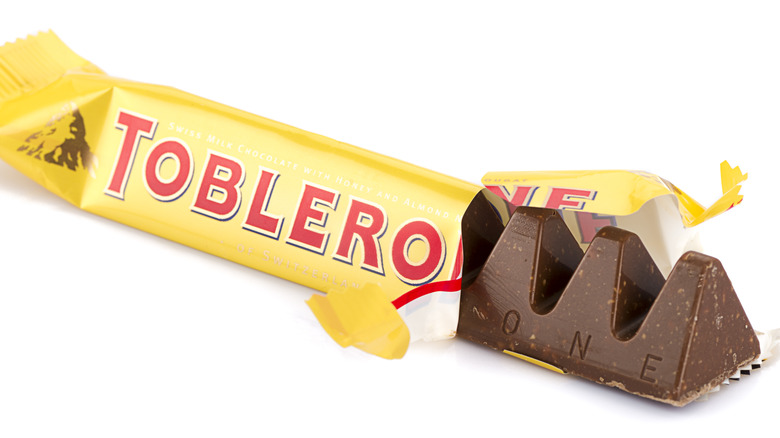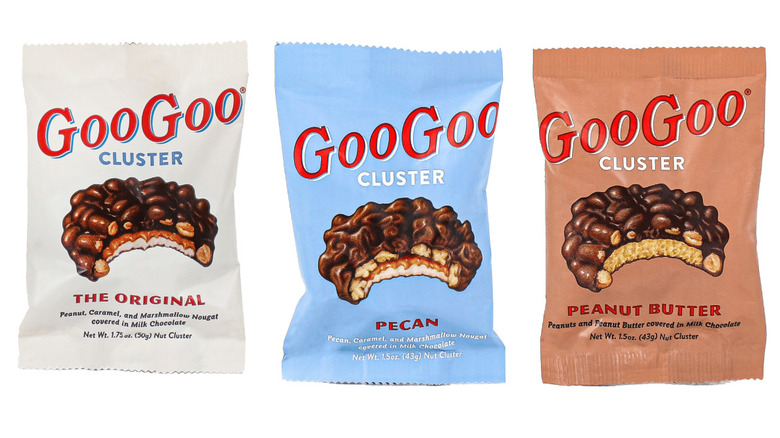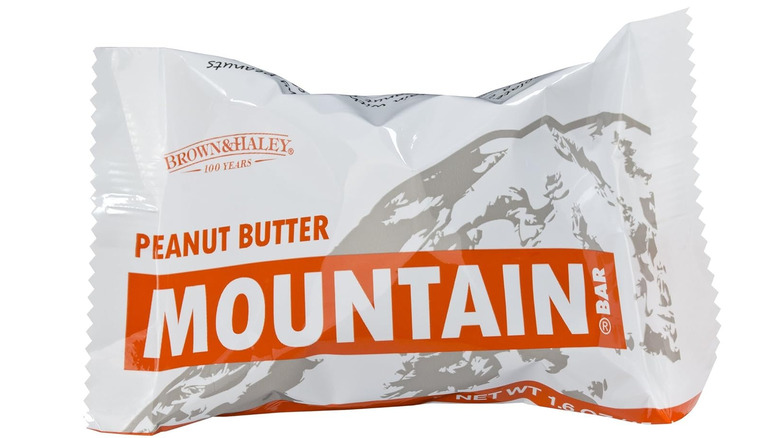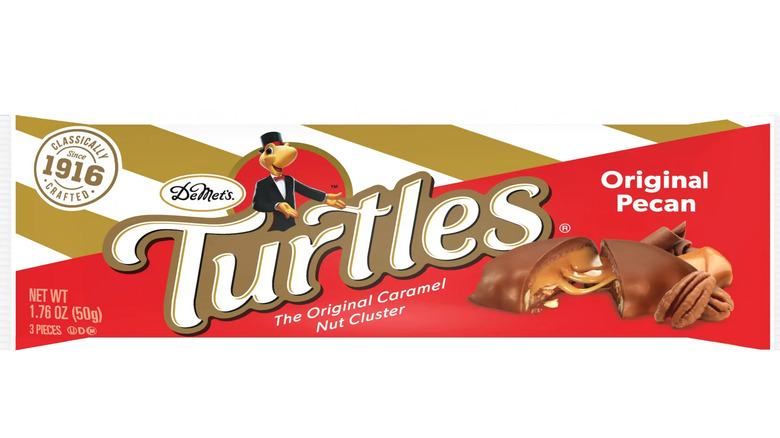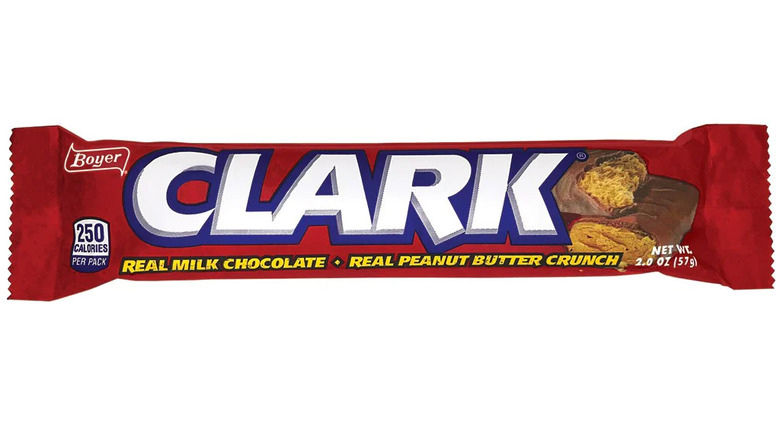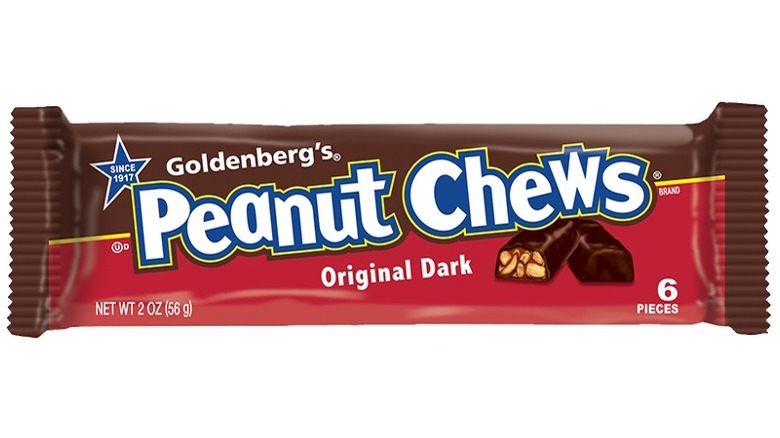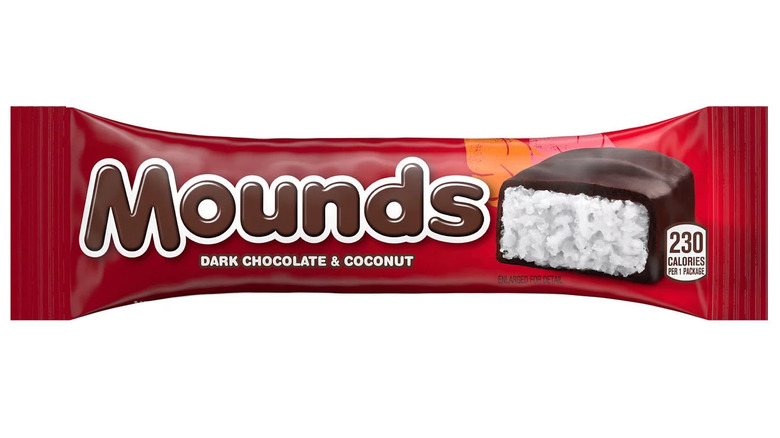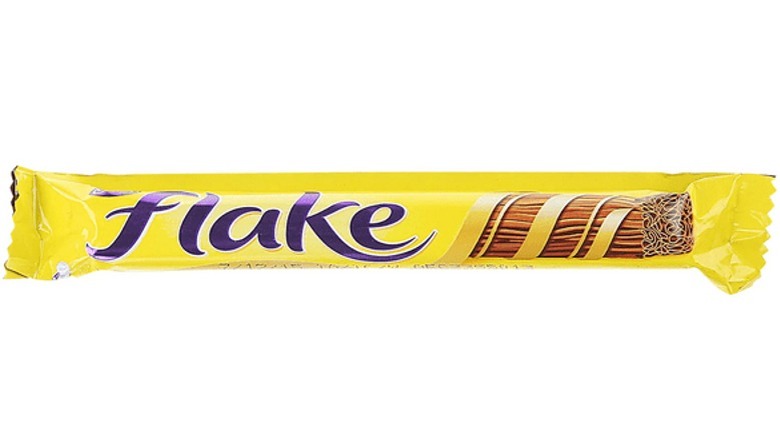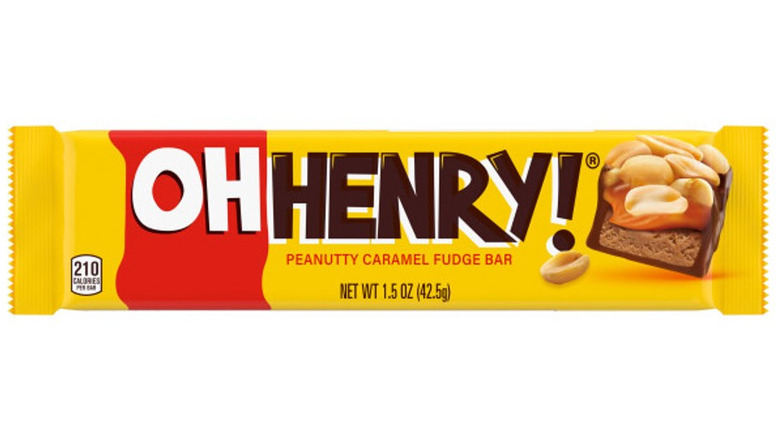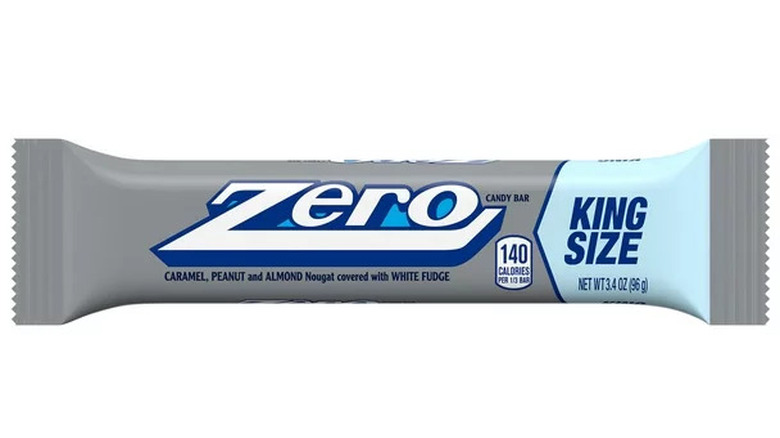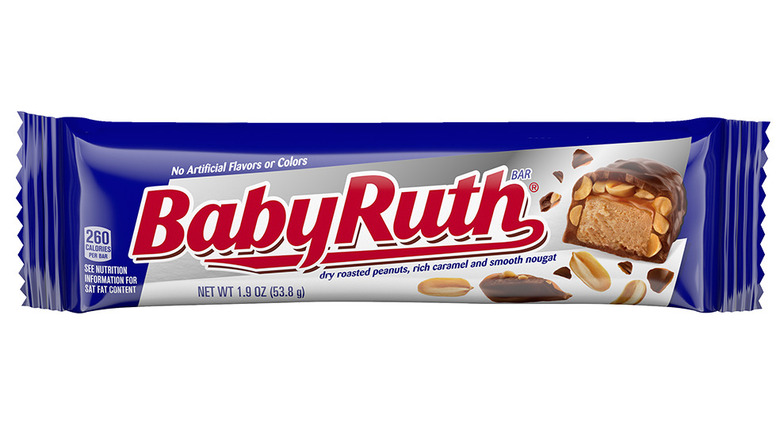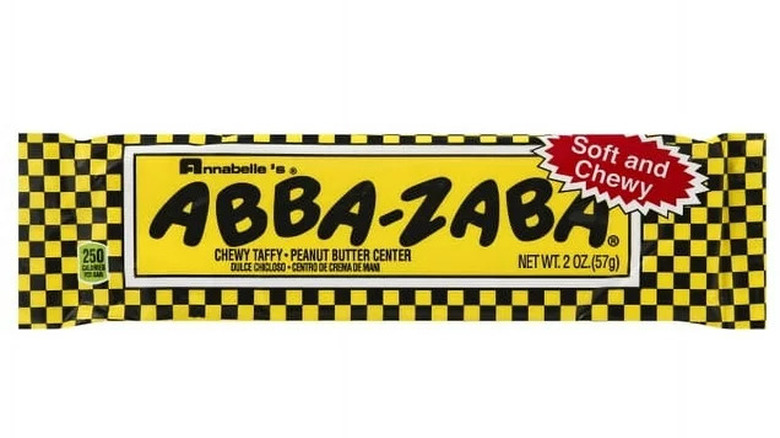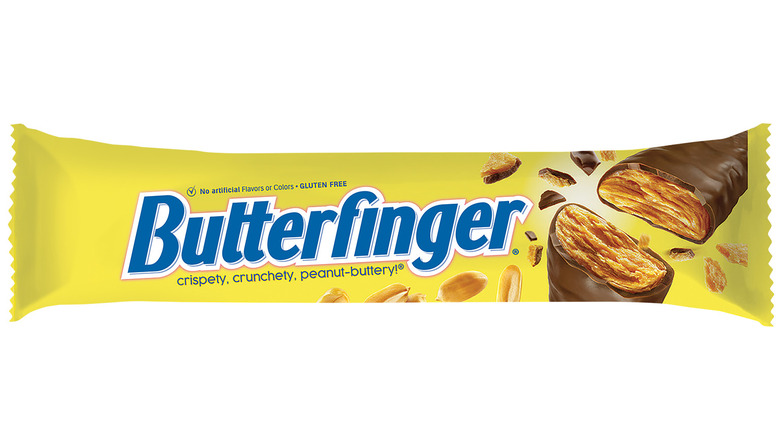17 Candy Bars That Have Been Around A Lot Longer Than You Realize
Chocolate and sugar have been sweet indulgences consumed in many forms by humans for thousands of years. It wasn't until the 16th century that chocolate made its way to Europe, and two centuries later, the Swiss and British started to form them into more portable bar forms. Once the public showed a large appetite for these innovative rectangular, sometimes rounded or mounded, confections, it seemed everyone wanted to perfect their own version of it, including those in North America.
The very first candy bar is believed to date back 1847, and the oldest one still on shelves today hails from 1866. Many bars have come and gone since, but some of these classic confections have proven their worth, passing the test of time and beloved by one generation after another. A few of these bars even found themselves in the battlefronts of the World Wars and remained popular back home during peacetime. Daily Meal has peeled back the wrappers of 17 such bars that have been around a lot longer than you might realize. We'll be taking a look at their humble beginnings, how they got their names, and how they endure to this day. This will be one of the sweetest history lessons you'll ever snack on. Enjoy.
1. Fry's Chocolate Cream (1866)
Joseph Fry began to sell chocolate in 1756, and almost a century later, his grandchildren hit upon a novel confection of a hardened, creamy paste made of cocoa powder and cocoa fat. In 1847, their company, J.S. Fry & Sons, debuted Britain's very first solid chocolate bar called Chocolat Delicieux a Manger. The dense bar wasn't exactly a hit with eaters, but it was the forerunner to the long-tenured Fry's Chocolate Cream, which started being sold in 1866.
Fry's merged with Cadbury in 1919, but the bar retained the family name. It went on to be made in flavors such as peppermint, raspberry, coffee, and cokernut, in addition to the original flavor. Television ads for Fry's have starred '60s supermodel Twiggy and James Bond actor George Lazenby, and one memorable late '70s ad summed up the chocolate bar's appeal as "slim, dark, sophisticated, yet underneath it all, a soft heart. A sweetness that will hold me all my life."
Fry's Chocolate Cream had been made at the Cadbury factory in Somerdale, England since 1919, but production of the bar shifted to Poland under new owners Kraft starting in 2011. While it is no longer a highly visible item highlighted in the Cadbury catalog, it still remains one of the oldest chocolate bars still on the market, and dear to many eaters' hearts. That includes Patricia Michelson, founder of La Fromagerie, who told The Independent in 2011, "They're my secret pleasure," and added, "They're the taste of my childhood."
2. Hershey's Milk Chocolate Bar (1900)
Milton Hershey first found sweet success with his Lancaster Caramel Company, but in 1893, he remarked to employee Frank Snavely, "Caramels are a fad; Chocolate is permanent. I am going to make chocolate" (via Hershey Community Archives). Hershey was captivated by chocolate-making machinery he had seen at that year's World's Columbian Exposition and began to experiment with one using fresh milk in its production. While a vanilla sweet chocolate bar was one of Hershey's first, in 1900, the milk chocolate namesake bar we all know and love was introduced.
The Hershey bar initially sold for 5 cents, a price that would amazingly remain the same until 1969, when it was bumped up to 10 cents. (The bar itself was made larger as well.) In 1908, a version with almonds was introduced. The famous all-caps "HERSHEY'S" lettering first adorned wrappers in 1912, and in a candy industry first, nutritional labeling was featured on the reverse side in 1973.
The Hershey bar's popularity has naturally spilled over into popular culture, borrowed for the name of a jazzy Stan Getz tune, mentioned in songs by George and Ira Gershwin, Jefferson Airplane, and Sonny & Cher, and deeply desired by both Ben Stiller and Christian Bale in Steven Spielberg's "Empire of the Sun." One of Don Draper's finest pitches on "Mad Men" remains his for Hershey, as he called it "the childhood symbol of love." Draper believes in the brand so much he tells company execs, "If I had my way, you would never advertise."
3. Cadbury Dairy Milk (1905)
The Cadbury family name's relationship to chocolate essentially began in 1824, when John Cadbury opened a grocery store in Birmingham, England, and sold items like cocoa and drinking chocolate. By 1889, the Cadburys were trying to beat the Swiss at their own sweet game by making milk chocolate. In 1905, chemist George Cadbury Jr. finally found the right balance by using a whole glass and a half of full cream. This bar's working title varied between Jersey, Highland Milk, and Dairy Maid. It got its final name when Mrs. E.M. Creacy, a daughter of a candy store owner, told a traveling Cadbury salesman, "I wonder you don't call it 'Dairy Milk' — it's a much daintier name" (via "The Cadbury Story").
Dairy Milk propelled Cadbury's success, which led to plenty of other chocolate bars that followed. Even when fresh milk was rationed during World War II, Cadbury still found a way to get bars into the mouths of its customers with skimmed milk powder-powered "Ration Chocolate." In the United States, the exclusive rights to produce and sell candy under the Cadbury name are owned by Hershey. This has been a bone of contention for some British expats in America, as the U.S. Dairy Milk bar differs from the one across the pond, and Hershey has prevented its import. 2024 marked the 200th anniversary of Cadbury, and as part of the celebrations, Dairy Milk bars we re-packaged with retro designs that harken back to 1915 and onward.
4. Toblerone (1908)
The Swiss Tobler family got into the candy business by selling others' products starting in 1868, and 31 years later, they opened their own chocolate factory. After Emil Baumann discovered the magic of a white nougat while in France, he and his cousin, company owner Theodor Tobler, came up with an Alps mountain range-shaped chocolate bar in 1908. It went by the name Toblerone, borrowing the family name and the Italian word for the honey and almond nougat ingredients found within, "torrone."
Toblerone's famous triangular packaging once featured an eagle, which was later replaced by a Bernese bear joined with an image of the Matterhorn mountain. The bars are a common sight at duty-free airport shops around the world and have made appearances in the "James Bond" film "On Her Majesty's Secret Service," "Clear and Present Danger," "Friends," and "The Week Of," where Steve Buscemi is overwhelmed by a gigantic one.
While Toblerone remains a popular bar in the 21st century, it doesn't exactly hit the same physical heights it once did. In 2016, in a move to save costs, the bar lost 10% of its size, prompting British consumer Tony Matthews to tell the Associated Press, "The shape of the bar may have looked like the Swiss Alps before, now it's a bit more Holland." After moving part of the candy's production to Bratislava, Slovakia, in 2023, it was stripped of its "Swissness" label and had to remove the Matterhorn and Swiss flag from its packaging.
5. Goo Goo Cluster (1912)
The Standard Candy Company of Nashville, Tennessee, did something rather unusual in 1912 when it created one of the first combination candy bars to make it to market — the Goo Goo Cluster, where the great taste talents of nuts, caramel, marshmallow nougat, and milk chocolate are unified. The name's origin came about when company owner Howell Campbell was on a streetcar, and a teacher suggested he use the first words his son had said, "goo goo." It also helped to market the candy, as its initial slogan was "Goo Goo! It's so good, people will ask for it from birth." It was later promoted as "A Nourishing Lunch for a Nickel", followed by "the South's favorite candy."
The cluster was a sponsor of the Grand Ole Opry's radio broadcast from 1966 to 2006, has appeared in "Masterminds" and "The Walking Dead," was sung about by Darrell Scott in "The Ballad of Martha White", and counts Tennessee native Dolly Parton as a fan. Even Ozzy Osbourne went batty over the brand when he visited the Nashville store while in town.
In a statement to Daily Meal, Laurie Spradley, vice president of operations at Goo Goo Cluster, said, "The loyal support of our devoted fans has allowed us to evolve beyond the classic recipe, introducing innovative variations such as Premium Goo Goos, Lil' Goos, Fine Chocolates, hot cocoas and more. With gratitude for our chocolate enthusiasts, we hope to continue serving customers for centuries ahead!"
6. Mountain Bar (1915)
While the Roca bar may be Tacoma, Washington, confectioners Brown & Haley's claim to candy fame, its introduction was preceded by another favorite on its roster — Mountain Bars. The mound of rich chocolate filled with ground peanuts and vanilla fondant was first marketed in 1915 as the Mount Tacoma bar, in honor of the nearby mountain now known as Mount Rainier. It became a favorite of the soldiers stationed nearby at Camp Lewis, who would later be longing for them while fighting overseas in World War I. In an advertisement from 1919, Brown & Haley stated it once received a letter from one such soldier who claimed that "he is going to eat so many Mt Tacoma Bars when he gets back that he'll bust" (via The News Tribune).
By 1923, the bar was being sold by its current name, and the cherry flavor was added that decade. It would take almost five decades more for another flavor to be added, when peanut butter-filled Mountain Bars came about in 1972. Past limited-run flavors have included raspberry, coconut, cappuccino, and mint. The treats are still made in the very same factory where they first rolled off and are popular in neighboring states like Oregon, Idaho, Montana, and California. While the bars are no longer handmade, Kathi Rennaker of Brown & Haley told MyNorthwest in 2020, "We currently produce 100,000 Mountain Bars in an eight-hour shift," adding, "We make about four million pounds of Mountain Bars per year."
7. Turtles (1916)
Chocolate-dipped pecans have been around since at least the late 19th century, but Chicago candy store owner George DeMet added caramel into the nut cluster bar mix in 1916. The leggy confection resembled a tortoise and was thus dubbed "Turtles." "Turtles" wasn't trademarked until 1945, and the name has been used as a generic term for the treat made by any chocolatier. By the 1950s, the brand had created a Mr. Turtle mascot, decked out in a tuxedo, spats, monocle, top hat, and cane, who brought a touch of class to the candy. Decades later, Mr. Turtle finally got to speak and was voiced by MTV personality Ken Ober.
Starting 1986, in an effort to help save sea Turtles, DeMet donated money to SeaWorld in an effort to save sea turtles. The company's president, Barry Fulford, told the UPI, "We wanted to do our part to help our candy's namesake" (via the Richmond Times-Dispatch). The company also helped to establish and sponsor an Adopt-a-Turtle program.
In 2007, private equity firm Brynwood Partners acquired the Turtles brand from Nestlé USA and brought back the DeMet's name to distribute it. Six years later, the Turkish-based owners of Godiva, Yildiz Holding, took the reins, improving the company's footprint in North America. The candies are now produced in Big Flats, New York.
8. Clark Bar (1917)
While it isn't the first combination candy bar in America, many do bestow that title on the Clark Bar. The milk chocolate-coated bar with a peanut butter crunchy center was created in 1917 for the war effort by David L. Clark, an Irish immigrant who began selling candy out of a wagon three decades earlier. After World War I ended, the bar's popularity grew, and in World War II, three quarters of the bars produced were sent to soldiers serving overseas. While Clark himself passed away in 1939, his name lives on in this precursor to the Butterfinger.
By 1960, the Clark Bar had gained a mascot boy named Clarkie and, over the years, has received free advertising straight from the lips of beloved sitcom characters on shows like "Seinfeld," "NewsRadio," "Uncoupled," "The Simpsons," and "Friends," as well as witty banter from "You've Got Mail." In 1981, the D.L. Clark Company pieced together 32,000 Clark Bars into a 3,000-pound singular one in an attempt to set the Guinness World Record for the world's largest candy bar.
Soon after, the Clark Bar endured a series of different owners, including Leaf Inc. and the New England Confectionery Co. When the latter went bankrupt, the Boyer Candy Company acquired the Clark Bar in 2018 and brought its production back to Pennsylvania. Boyer CEO Anthony Forgione told The Pittsburgh Post-Gazette, "We did a ton of interviews with people who worked at the factory in Pittsburgh to get it exactly how the Clark Bar was made."
9. Goldenberg's Peanut Chews (1917)
David Goldenberg was a Romanian immigrant who settled into a sweeter life in Philadelphia by opening a candy shop in 1890. During World War I, the Goldenberg Candy Company pitched in by providing chocolate rations for the soldiers. Years later, Goldenberg's son Harry recalled to the The Philadelphia Inquirer, "We always made a walnut loaf, and it was very popular. When walnuts got to be too expensive, we switched to the same thing in peanuts." By 1917, that bar was sold as Goldenberg's Peanut Chews. In order to make less of a mess for moviegoers in the 1930s, the company produced a bite-sized version that became known as Chew-ets, which also come in milk chocolate. Goldenberg's Peanut Chews have mainly had an East Coast following but have made their way across the world, from Iceland to Taiwan. Its fans include such luminaries as Bruce Willis, Neil Diamond, Barbra Streisand, and plenty of U.S. senators who've grabbed them from the Senate's famed "candy desk."
Goldenberg's Peanut Chews remained a family business until 2003, when it was acquired by fellow Pennsylvanians Just Born, makers of Peeps and Mike and Ike. Just Born tinkered with the product in order to launch it nationwide. Gone was the all-natural bar, now infused with preservatives, and in an even more blasphemous move, the packaging was redesigned, with the name "Goldenberg's" excised altogether. After sliding sales in its core market, Peanut Chews went retro in 2011, regaining its classic packaging and its good founder's possessive name.
10. Mounds (1920)
Peter Paul Halajian went from selling homemade candy out of a basket to opening two Connecticut ice cream and candy shops and, with the help and investment of some fellow Armenian immigrants, found sweet success as a wholesaler of treats. In 1920, the Peter Paul Manufacturing Company introduced the Mounds bar, featuring coconut richly dipped in chocolate, which would later be hailed in ads as "indescribably delicious." Halajian died seven years later, but Mounds kept climbing to new heights. In the 1930s, the company gave buyers their nickel's worth by including two bars within one package of Mounds, and it billed itself as the world's largest user of coconut in the '40s.
While today, the Almond Joy bar seems like it's been a nutty alternative partner to Mounds forever, it actually didn't come around until 1946. The two candies are often advertised together, and Almond Joy's iconic slogan, "Sometimes you feel like a nut, sometimes you don't," with lyrics by Leo Corday and music by Leon Carr, perfectly sums up each candy's toothsome appeal. The earworm jingle was such a part of late 20th century Americana that even "Weird Al" Yankovic covered it in concert. Mounds has also been seen in scenes from "Back to The Future," "Scarface," and "The Goldbergs." In 1978, Peter Paul Incorporated merged with Cadbury Schweppes, and a decade later, Hershey took over its U.S. confections, which included Mounds, Almond Joy, and York Peppermint Patties.
11. Cadbury Flake (1920)
Making a mess is what Cadbury's Flake bar has always been about. The origin story of the crumbly candy, in the company's own words: "In 1920, a factory employee noticed how the chocolate overflowing from a mold fell into folds, which then inspired the idea for the Flake." The bar started to find a new home during the summer in cones of ice cream. In 1930, the company even made a shorter version to better fit called the Flake 99. In modern times, bits of it have appeared in a British version of the McFlurry.
In the late 1960s, suggestive TV ads for the Flake started airing and were almost as indulgent as the candy itself. The ads boasted that, "Only the crumbliest, flakiest chocolate in the world would taste like chocolate never tasted before." The women who starred in them came to be known as the Flake Girls and have included "Bond" girl Eva Rueber-Staier and, in a more toned-down 2000s sales pitch, singer Joss Stone. Cadbury's Flake has also had its name praised in the song "Here Come The Young Men" by the Courteeneers.
12. Oh Henry! (1920)
The exact origin of the Oh Henry! bar's name has been up for debate since its inception in 1920. Theories have included an homage to the writer O. Henry, or even a nod to a Kansas candy maker who may have originally created the confection of peanuts, caramel, and fudge decked out in milk chocolate. The main one that has long been promoted by the brand is that the girls who worked at founder George H. Williamson's candy shop took a liking to a young customer with that name and asked him to do favors for them by calling, "Oh Henry..."
While most candy bars at the time sold for 5 cents, Oh Henry! was sold at a more premium price of 10 cents. It was even suggested in ads during the 1920s to slice the bar into pieces and serve to guests. That culinary practice was later lampooned on "Seinfeld," and the bar was also praised in a different episode. Other companies wanted to copy Williamson's success but hit a litigious wall when bars like Oh Honey and Oh Jonnie proved to be way too similar. Oh Henry! even once had a "little sister" bar named Oh Mabel!
Oh Henry! exchanged hands from Nestle to Ferrero in 2018, alongside buddies Baby Ruth and Butterfinger, but was unceremoniously discontinued soon after. Hershey makes a different bar under the name Oh Henry! in Canada, and in America, Ferrero has occasionally brought back Oh Henry! for limited-time runs.
13. Zero (1920)
In 1911, Frank Martoccio was running his Minneapolis-based F.A. Martoccio Macaroni Company, and the need to replace broken machinery led him to buy Pratt and Langhoft Candy. Martoccio innovated a new synthetic way to keep candy from melting and, in 1920, debuted a white fudge candy bar filled with caramel, peanut, and almond nougat. The original name of the product was the Double Zero, and around 1934, the company, now known as the Hollywood Candy Company, ditched the "Double" part. The Zero's packaging used to play up its icy-looking appearance, featuring images of polar bears, igloos, icicles, and snow. In the 1950s, the candy's spokesman was Mr. Zero, portrayed by Maxie Bornstein, who would drive around the country in a logo-branded car.
Due to its numerical value, the Zero bar has often been used as a reward candy, doled out to recipients like plant workers who had an accident-free year and football teams' defenses not giving up a score. In one case of the latter, Alabama high school Coach Chip Harris said of his team, "The defense promised I would weigh 300 pounds by the end of the season" (via The Opelika-Auburn News). It has also been handed out for less celebratory reasons, like being given to tax filers expecting no returns or sent by Los Angeles Angels fans who were once salty about a cold streak by Hall of Famer Rod Carew. Today, Zero is produced by the Hershey Company, which has helped to expand its reach in stores.
14. Baby Ruth (1921)
The Kandy Kake chocolate bar had been on the Curtiss Candy Company's roster for over 20 years before it was renamed Baby Ruth in 1921. That just so happened to coincide with the rising career of New York Yankee slugger Babe Ruth. Years later, when asked if it was named after him, Ruth said, "That's the only one I never got a dime out of," adding, "I tried but they swore they named their candy after Grover Cleveland's niece. They said her name was Ruth and everybody called her Baby Ruth" (via The Gazette). The company has stuck to the story that the bar is named after Ruth Cleveland, who was actually Cleveland's daughter, although she died in 1904.
To help ensure that things really took off for the bar, which sports peanuts, caramel, and nougat housed in a chocolate coating, Curtiss' president, Otto Schnering, came up with the idea to drop them over cities from planes. The bar's rapid success even led Schnering to expand the use of the Baby Ruth name to a peppermint gum product, as well as his own racing hydroplane.
Baby Ruth has been shouted out on the TV show "Taxi" and had memorable nods in the movies "The Goonies" and "The Sandlot" and in a song by John Prine. While Babe Ruth probably wasn't a fan of the bar, in 2023, the Yankees partnered with current owners Ferrero to bring the candy and a limited-edition Baby Ruth Milkshake to Yankee Stadium concession stands
15. Abba-Zaba (1922)
California candy company Colby & McDermott first brought Abba-Zaba to market, with the name trademarked on Valentine's Day in 1922. The white taffy bar stuffed with chocolate and peanut butter was originally outfitted with a wrapper that wouldn't exactly fly today, featuring horrendously stereotyped cartoon African tribal hunters to give the bar an exotic identity. That insensitive wrapper was eventually replaced by the more eye-catching one it sports now, where a bright yellow base is checkered with black boxes like a taxi cab.
The made-up name has always been fun to say, celebrated by the Ernie Bushmiller comic strip character Nancy and noted as Dave Chappelle's "only friend" in the 1998 movie "Half Baked." The name was also borrowed by Captain Beefheart And His Magic Band for a song off their 1967 "Safe As Milk" album, and the wrapper was even used to advertise a concert by Deep Purple a year later.
The bar passed hands through several companies, including Doumak, the Cardinet Candy Company, and Ralston Purina, and is currently made by the Annabelle Candy Company. Annabelle has done big things for Abba-Zaba — literally. In 2016, the company set the Guinness World Record for largest taffy, weighing in at 524 pounds. While Abba-Zaba remains a beloved regional candy eaten mostly by Californians, it can be found across America.
16. Charleston Chew (1922)
Actor-turned-candy man Donley Cross and his partner Charlie Fox and their Fox Cross Company were all about nougat-filled, chewy-named candies. In 1920, they launched the chocolate chewing nougat Nu Chu bar, and two years later, seizing upon the Charleston dance craze of the Jazz Age, used the South Carolinian city's good name for a new chocolate-covered vanilla nougat candy bar. The Charleston Chew bar, which for a long while included an exclamation point at the end of its name, was originally manufactured in the bay area of California and has also called Chicago and the Boston area home.
When Nathan Sloane took over Fox Cross Company in 1957, the Charleston Chew brand expanded in both flavors and ways to enjoy. By the 1960s, the boxes that contained them encouraged eaters to "freeze them too and crack 'em up," and in the following decade, the standard vanilla flavor was joined by chocolate, strawberry, grape, cherry, and even banana options.
The candy brand exchanged hands to Nabisco, then Warner-Lambert, before moving, along with Junior Mints, Sugar Daddy, and Sugar Babies, to Tootsie Roll Industries in 1993. Five years later, Tootsie did fans an amazing service by creating Charleston Mini Chews, which is one of the more common forms the candy is enjoyed in to this day. Charleston Chew, of which approximately 65 miles are produced daily, has been name-dropped by Richard Nixon on "Futurama" and rapped about by Eminem.
17. Butterfinger (1923)
The slippery term "butterfingers" dates back to 1615 and, two centuries later, started to be applied to error-prone baseball players. The term took on a more delicious meaning in the 1920s, when the Curtiss Candy Company, fresh off the success of the pseudo-baseball-named Baby Ruth bar, borrowed it for its new crispety, crunchety, peanut-buttery bar covered in chocolate. The exact date of the Butterfinger bar's launch is somehow lost to time, but eventual owner Nestlé celebrated its 90th-ish birthday in 2013, making 1923 the unofficial, official year of origin.
Butterfinger re-entered pop culture when Bart Simpson signed on a spokes-toon in the late 1980s. Among the bar's biggest fans are Tina Turner and Travis Kelce, and its praises have been sung in tunes by Adam Sandler. It's also appeared in shows like "Parks & Rec" and been hurled at baseball players who make gaffes in the field.
When the bar exchanged ownership from Curtiss Candy Company to Nabisco, the recipe was lost in the shuffle, and a new one had to be created. That wasn't the end of the bar getting its production tweaked, as it got an ingredient refresh by its new owner Ferrero in 2018. In a statement to Daily Meal, Neal Finkler, vice president of marketing at Ferrero, said, "Ferrero has made it a priority to revitalize Butterfinger and Baby Ruth and ensure they will be loved by Americans for generations to come."
